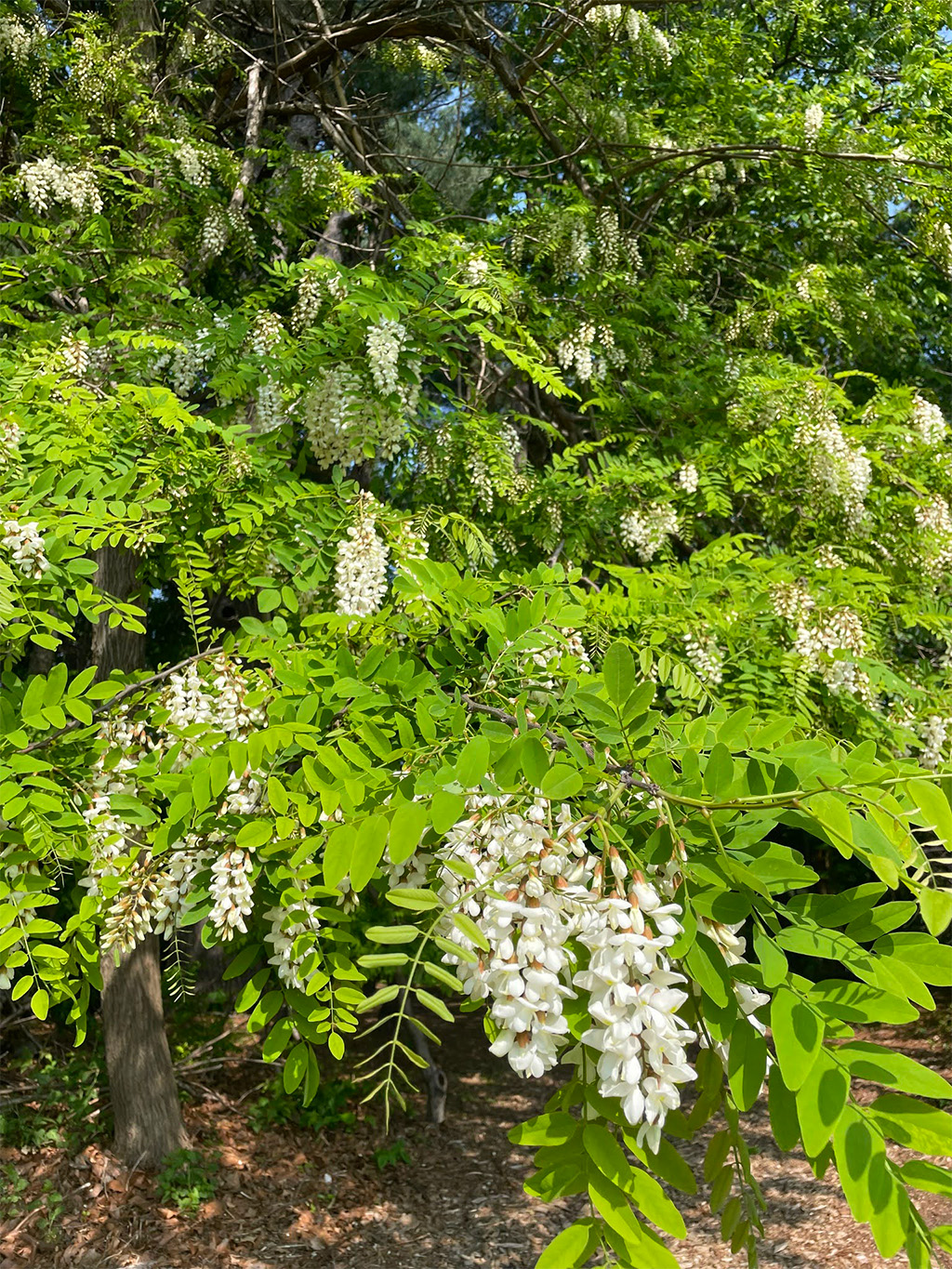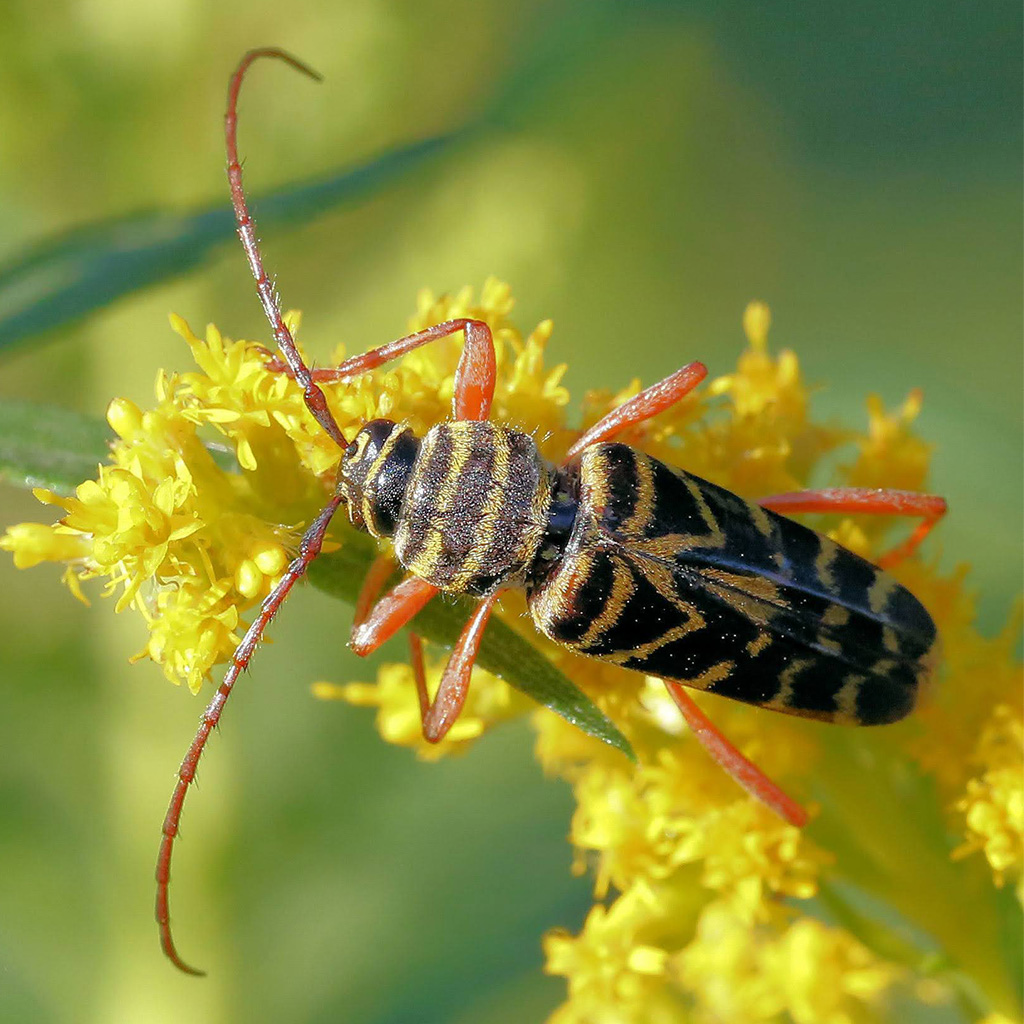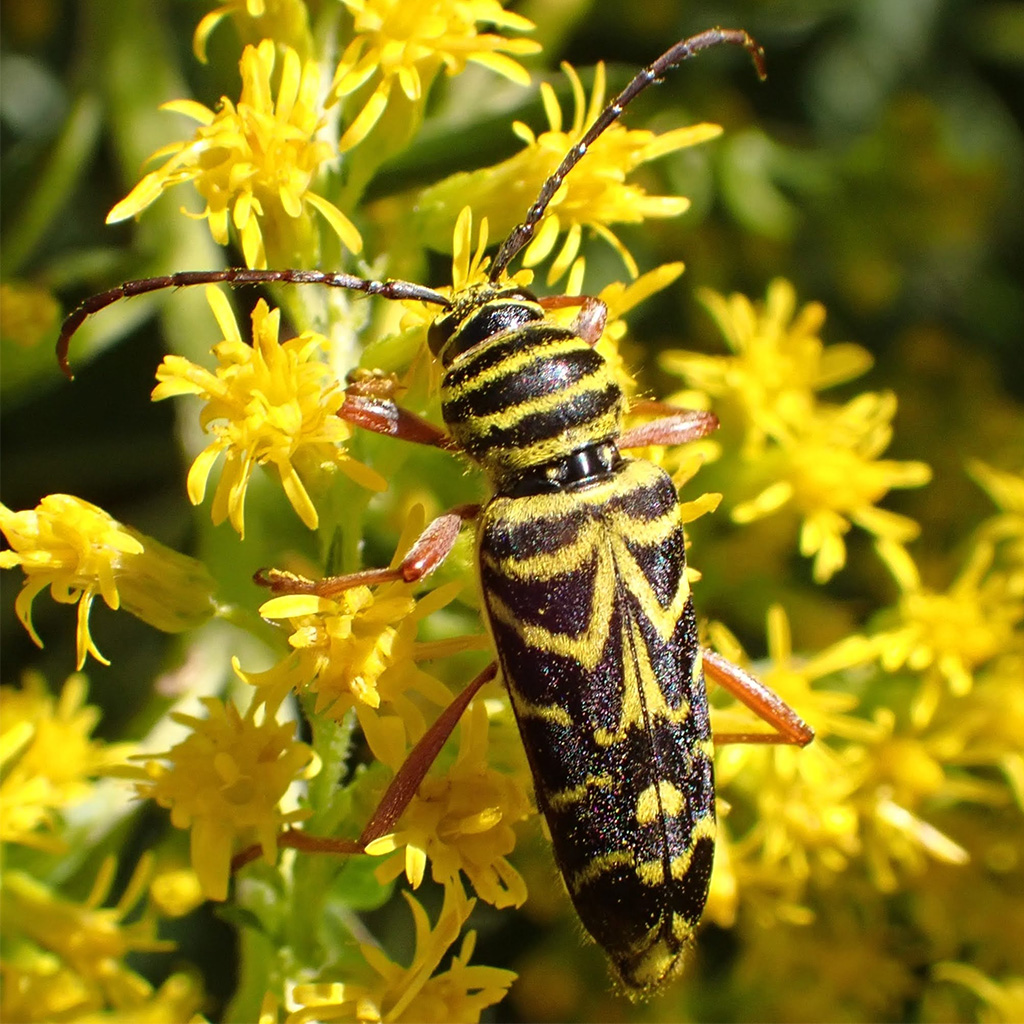Not a bee nor a wasp you see, but a locust borer linked to trees loved and hated since the 1600s

A locust borer on goldenrod displays its long black antennae and reddish legs on Aug. 30. (Photo: Robert Gessing)
This is the time of year for goldenrod to bloom and attract its many insect visitors, one of which is the yellow-and-black locust borer (Megacyllene robiniae), a type of long-horned beetle. Its markings mimic the coloring of stinging wasps and bumblebees – a disguise that discourages predators from eating it. If you look closely you will see a difference: W-shaped stripes on its wing covers.
This time of year, the female locust borer feeds on goldenrod pollen in the morning. In the afternoon, she flies to black locust trees, where she lays eggs in cracks in the bark. In about a week, the eggs hatch into small, white legless grubs who bore into the bark. There they build 1-inch burrows in which they hibernate for the winter. When spring arrives and the tree buds, the grubs tunnel upward and inward toward the center of the trunk. Wet sap spots on the bark in early spring indicate that the larvae are tunneling into the woody part of the tree.

Black locust trees are easy to find in our area, including at Danehy Park, Harvard University and here at Fresh Pond Parkway, seen May 22. (Photo: Helen Weex)
The grubs feed and grow throughout the spring and summer. They push out white wood dust and frass (dried poop) in late spring or summer as they tunnel into sapwood. If you listen carefully, sometimes you can even hear the grubs chomping! The grubs reach maturity (reaching an inch in length) in late July or early August. The dust and frass pushed out is yellow when they reach the heartwood. Then each grub forms a pupa (chrysalis). It takes about a month for the larvae to metamorphose into adults. The adult beetles emerge in August and September, when goldenrod blooms. They are active until the first frost.
Black locust trees have a complicated history in Massachusetts. Although the trees are native in the Southeast, the trees are invasive here and illegal to sell. They grow quickly and spread mostly by sprouting new trees from the roots of an existing one. If you cut down one, new trees will sprout around it. If the tree is damaged, more root suckers form. Thus, black locusts form dense stands of trees that crowd out native plants.

Locust borers have a yellow W-shaped band across their forewings. (Photo: Robert Gessing)
Black locust trees are in the legume family. Like beans or peas or clover, they pull nitrogen from the air and convert it into soil nitrogen. The increased nitrogen level inhibits the growth of native plants, which are adapted to nitrogen-poor soil.
But the black locust tree has characteristics that have made it enormously appealing. It contains a natural preservative that makes it resistant to decay: The wood does not rot, even when submerged in water or mud, making it valuable for fence posts, docks, decks, bridges and buildings. The wood is also dense and hard. It puts out a great deal of heat when it burns, and it burns for a long time. Black locust trees can stabilize erosion-prone slopes because of their dense interlacing root system.
The usefulness was not lost on early people. When European colonists arrived in Jamestown, they discovered that the Powhatan Indians used the wood to make bows. In 1730, William Byrd II wrote that the wood of the locust tree “is the toughest in all the world, and almost cannot be broken.”

A locust borer feeds on goldenrod in West Cambridge on Sept. 20. (Photo: Becca Evans)
Colonists in Jamestown built homes using black locust corner posts.“They erected each of their little hovels on four only of these trees, pitched into the ground to support the four corners; many of these posts are yet standing, and not only the parts underground, but likewise those above, still perfectly sound,” Mark Catesby wrote 100 years later.
Black locust trees may even have helped the United States win the War of 1812. On Sept. 11, 1814, on Lake Champlain between New York and Vermont, the American fleet battled the British fleet. When cannonballs from the American fleet hit the British ships, the British ships fell apart. (The British built their ships using oak nails.) When British cannonballs hit the American ships, however, the American ships held together. (The Americans built their ships using black locust nails.) The Americans won the battle decisively. The following year, Great Britain started importing thousands of locust nails to refit the British navy. By 1820, Philadelphia was exporting as many as 100,000 black locust nails per year to Great Britain.

A locust borer in Black’s Nook in Cambridge on Aug. 24, 2021. (Photo: Zachary Dankowicz)
Black locust wood has been used for many other projects as well. Engineers built the Brooklyn Bridge in 1883 using black locust suspension cables. George Washington’s home, Mount Vernon, has a fence made from black locust wood. This fence still stands. The Harvard Forest (4,000 acres in Central Massachusetts) contains some 100-year-old fence posts made of black locust.
Black locust borers do not usually do a great deal of harm to healthy older black locust trees. Young trees and unhealthy trees are more susceptible. Even then, the locust borer does not usually kill a tree, though the tunnels in trunks and branches make the trees more prone to breaking in wind or ice storms.
If you happen upon a field of goldenrod this fall, look closely for the black locust borer on the stalks. You will know that black locust trees are nearby – a tree with a complicated but fascinating history in New England.
![]()
Reader photo

Rajeev Kumar discovered this turkey in his backyard in Ann Arbor, Michigan.
![]()
Have you taken photos of our urban wild things? Send your images to Cambridge Day, and we may use them as part of a future feature. Include the photographer’s name, date and the general location where the photo was taken as well as any other relevant information.
Jeanine Farley is an educational writer who has lived in the Boston area for more than 30 years. She enjoys taking photos of our urban wild things.


